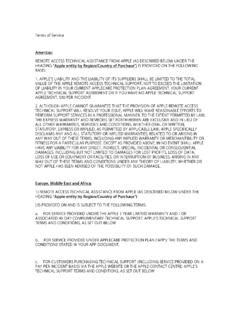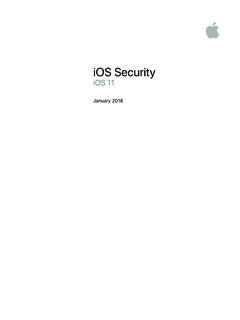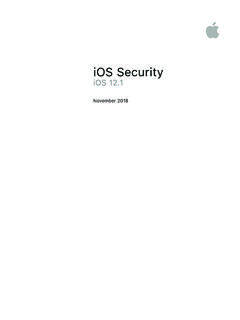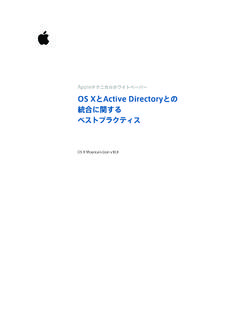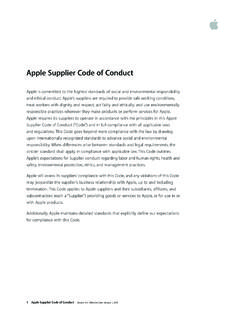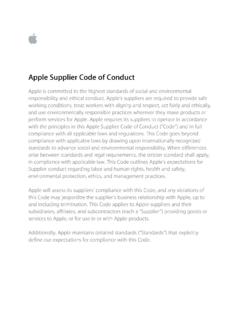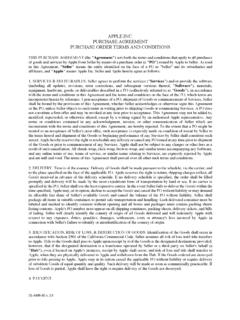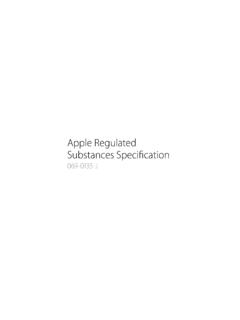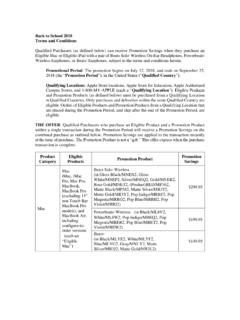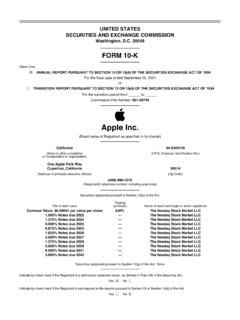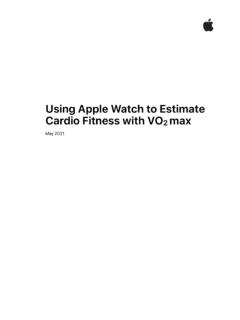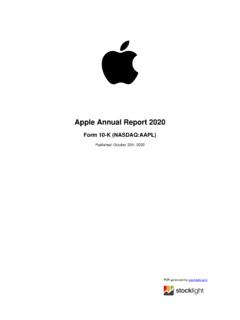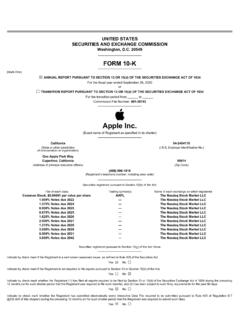Transcription of Using Apple Watch for Arrhythmia Detection
1 Using Apple Watch for Arrhythmia Detection December 2020. Contents Overview 3. Introduction ..3. PPG-Based Arrhythmia Detection 3. Technical and Feature Description ..3. Preclinical Clinical Validation ..5. Apple Heart Study ..5. AHS Sub-Study Experiment Design ..5. Results ..6. ECG-Based Detection 6. Technical and Feature Description ..6. Preclinical Development ..7. Clinical Validation ..7. Experiment Design ..7. ECG Clinical Validation Results ..8. ECG Clinical Validation Study ..12. Results ..14. Conclusions 17. Using Apple Watch for Arrhythmia Detection December 2020 2. Overview Apple Watch customers have access to two software as medical device features to detect heart arrhythmias such as atrial fibrillation (AFib): the Irregular Rhythm Notification Feature (IRNF) and the ECG app. On Apple Watch Series 1 or later, the IRNF analyzes pulse rate data collected by the photoplethysmograph (PPG) sensor to identify episodes of irregular heart rhythms suggestive of AFib, and it provides a notification to the user when it detects an episode.
2 On Apple Watch Series 4, Series 5, and Series 6, the ECG app can generate an electrocardiogram (ECG) waveform similar to a Lead I electrocardiogram, then provide a classification of that waveform as sinus rhythm (SR), atrial fibrillation (AF), high or low heart rate, or inconclusive; with ECG , additional classifications of AFib with high heart rate and poor recording are available. This paper provides a detailed understanding of the capabilities of these features, including testing and validation. Introduction AFib, a type of irregular heart rhythm in which the atria of the heart beat irregularly and sometimes rapidly, is a leading cause of stroke. But because AFib is often asymptomatic, many individuals with AFib may be unaware they have this condition. The combination of stroke risk, asymptomatic presentation, effective pharmacologic treatments minimizing stroke risk, and the increasing market penetration of consumer devices with the potential to detect AFib have increased interest in the early identification of AFib outside the clinical setting.
3 With watchOS or later, Apple Watch Series 1 and later are able to use PPG signals combined with an algorithm to identify periods of irregular pulse suggestive of AFib. In addition to Using this PPG-based identification algorithm, Apple Watch Series 4, Series 5, and Series 6 also have an electrical heart sensor that, when Using the ECG app, enables the generation and analysis of an ECG similar to a Lead I ECG. PPG-Based Arrhythmia Detection Technical and Feature Description Apple Watch has an optical heart sensor that uses green LED lights paired with light-sensitive photodiodes to detect blood volume pulses in a user's wrist Using photoplethysmography. These sensors and underlying algorithms are the basis for the heart rate (HR) and heart rate variability (HRV) Detection enabled on Apple Watch Series 1 and later. To determine HRV, Apple Watch captures a tachogram a plot of the time between heartbeats every two to four hours. Beginning with watchOS , users may also choose to enable an Arrhythmia Detection feature that uses these tachograms.
4 To use the Irregular Rhythm Notification Feature on Apple Watch , users must first complete onboarding in the Health app on their paired iPhone to learn how to use the feature and receive education regarding AFib. For more information about the user experience, visit Using Apple Watch for Arrhythmia Detection December 2020 3. If the PPG-based Arrhythmia Detection is enabled, Apple Watch classifies each tachogram Using a proprietary algorithm to determine if an irregular rhythm might be present. An irregular tachogram initiates a cascade of more frequent tachogram collection as frequently as possible, subject to a minimum spacing of 15 minutes and analysis. Apple Watch collects and analyzes tachograms only if the user remains still enough to obtain a reading. Because of this, the algorithm isn't always monitoring the user, but rather is doing so opportunistically when adequate signal is available for collection and analysis. If five out of six sequential tachograms including the initial one are classified as irregular within a 48-hour period, the user is notified of the potential Arrhythmia .
5 In addition to receiving the notification, the user can access more information related to these irregular tachograms in the Health app (Figure 1). If two tachograms are classified as not irregular before the threshold is reached, the cycle is reset and tachogram collection returns to the baseline rate every two hours. Figure 1: Health App View of Irregular Rhythm Measurements In the Health app, users can see the times when the algorithm identified an irregular tachogram that contributed to a notification (left). Tapping a date and time allows a user to visualize the beat-to-beat measurements calculated from each tachogram. Using Apple Watch for Arrhythmia Detection December 2020 4. Preclinical Development Prior to clinical testing, studies were conducted to develop the PPG-based Detection algorithm and to evaluate algorithm performance across a variety of conditions and user behaviors. Among these were deep breathing, riding in a car, hand tremors and motion, reduced hand or wrist perfusion, overnight wear, rapid ventricular response in individuals with AFib, and other arrhythmias.
6 These studies were performed in 2300 control subjects and more than 500 subjects with AFib. Because PPG relies on light absorptivity, the Arrhythmia Detection algorithm was tested across a variety of skin types and tones to ensure that sensor platform adjustments for skin tone were sufficient in the context of the algorithms used to detect arrhythmias. Melanin has high absorptivity at the wavelength used by the green LED on Apple Watch , making PPG heart rate measurement potentially more difficult in darker skin tones. To account for this, the Apple Watch sensing platform adjusts LED current (and hence light output), photodiode gain (sensitivity to light), and sampling rate to ensure adequate signal amplitude across the full range of human skin tone. For validation purposes, million tachograms from 1124 subjects (51 percent female) with varying skin types and tones were analyzed (based on Fitzpatrick skin types and spectrophotometer measurements of skin lightness at the wrist).
7 As the primary engineering concerns focused on signal amplitudes in individuals with dark skin, nearly 5 percent of enrolled subjects had Fitzpatrick type VI skin. Validation efforts demonstrated no significant difference in algorithm sensitivity or specificity across skin types or tones. Clinical Validation Apple Heart Study The Apple Heart Study (AHS) is a prospective, single-arm pragmatic study conducted virtually to evaluate the ability of the Apple Watch based irregular pulse notification algorithm to identify arrhythmias suggestive of AFib. In the study, if a user met the five-out-of-six threshold, the user received an iPhone and Apple Watch notification and had the option of contacting a telehealth study physician and receiving an ambulatory ECG patch, the ePatch (from BioTelemetry, Inc. in Conshohocken, Pennsylvania). Participants were instructed to wear the ePatch for up to seven days, but data collected from a participant were considered adequate with a minimum analyzable time of one hour.
8 The detailed results of AHS were published in November 2019 in the New England Journal of Medicine (Perez, Marco V., et al. Large-scale assessment of a smartwatch to identify atrial fibrillation. New England Journal of Medicine (2019): 1909 1917). AHS Sub-Study Experiment Design A sub-study of data collected in AHS was conducted to determine if the tachogram classification algorithm (individual or spot tachogram) and the confirmation cycle algorithm (alert-level, five out of six tachograms). have acceptable positive predictive value (PPV) compared with the ePatch monitoring in identifying irregular rhythms consistent with AFib in a subset of AHS participants. AHS investigators were aware of the sub-study, subsequent analyses, and data submission to the FDA, but they were were blinded to the sub-study results while AHS was ongoing. The institutional review board (IRB) that approved AHS. determined that this sub-study was exempt from IRB oversight.
9 All AHS participants provided informed consent, which included the use of their study data for the purposes of the sub-study. Using Apple Watch for Arrhythmia Detection December 2020 5. Sub-study data were collected from AHS participants enrolled between November 30, 2017, and June 22, 2018. The subjects in this sub-study received an irregular rhythm notification from the AHS app and subsequently received and wore the ePatch for interpretation of the ambulatory ECG findings. The initial irregular tachograms leading to the first notification and potentially launching the first telehealth encounter weren't analyzed as part of this sub-study; only irregular tachograms and notifications that occurred while a user was wearing the study-provided ePatch were analyzed. Two independent ECG adjudicators with board certification in cardiology or electrophysiology provided review and adjudication of ECG strips, classifying them as SR, AFib, another irregular rhythm, or unreadable.
10 If the adjudicators didn't agree, a third, similarly qualified adjudicator evaluated the strip. These adjudicators were blinded to the tachogram classification. The adjudicator ECG classification and algorithm-determined tachogram classification were securely sent to the study statistician for data analysis. Results Of the 226 sub-study participants who received an initial Arrhythmia notification and wore an ePatch for approximately one week, percent (94 participants) had AFib detected by the ePatch. During concurrent wear of Apple Watch and an ePatch, 57 out of the 226 participants received an AFib notification that is, they had five out of six consecutive tachograms classified as irregular. Of those 57, percent (45 participants) showed concordant AFib on the ePatch data, and percent (56. participants) showed AFib or other clinically relevant arrhythmias. These results demonstrate that, while in the majority of cases the notification will accurately represent the presence of AFib, in some instances a notification may indicate the presence of an Arrhythmia other than AFib.
